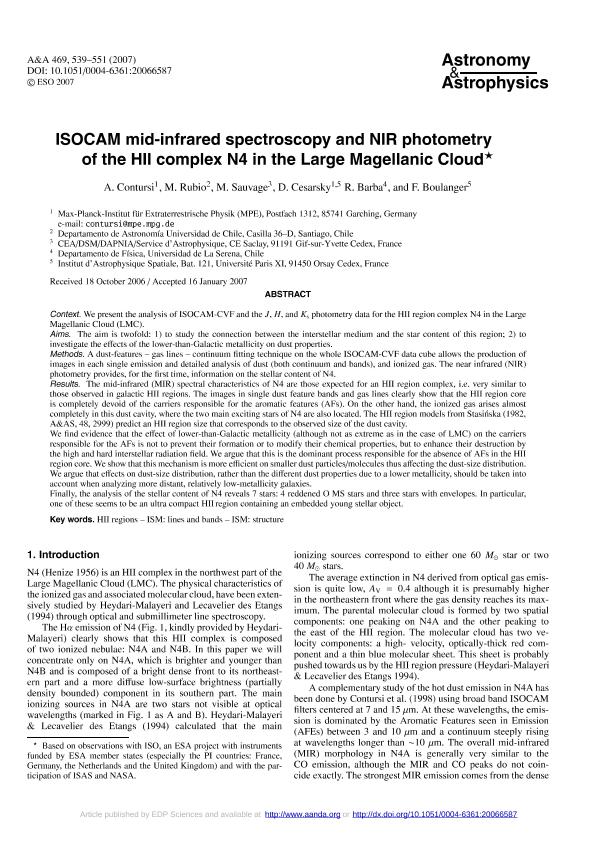Mostrar el registro sencillo del ítem
dc.contributor.author
Contursi, A
dc.contributor.author
Rubio, M.
dc.contributor.author
Sauvage, M.
dc.contributor.author
Cesarsky, R.
dc.contributor.author
Barba, Rodolfo Hector

dc.contributor.author
Boulanger, F
dc.date.available
2023-10-11T13:22:00Z
dc.date.issued
2007-12
dc.identifier.citation
Contursi, A; Rubio, M.; Sauvage, M.; Cesarsky, R.; Barba, Rodolfo Hector; et al.; ISOCAM mid-infrared spectroscopy and NIR photometry of the HII complex N4 in the Large Magellanic Cloud; EDP Sciences; Astronomy and Astrophysics; 469; 2; 12-2007; 539-551
dc.identifier.issn
0004-6361
dc.identifier.uri
http://hdl.handle.net/11336/214799
dc.description.abstract
Context: We present the analysis of ISOCAM-CVF and the J, H, and Ks photometry data for the HII region complex N4 in the Large Magellanic Cloud (LMC). Aims: The aim is twofold: 1) to study the connection between the interstellar medium and the star content of this region; 2) to investigate the effects of the lower-than-Galactic metallicity on dust properties. Methods: A dust-features - gas lines - continuum fitting technique on the whole ISOCAM-CVF data cube allows the production of images in each single emission and detailed analysis of dust (both continuum and bands), and ionized gas. The near infrared (NIR) photometry provides, for the first time, information on the stellar content of N4. Results: The mid-infrared (MIR) spectral characteristics of N4 are those expected for an HII region complex, i.e. very similar to those observed in galactic HII regions. The images in single dust feature bands and gas lines clearly show that the HII region core is completely devoid of the carriers responsible for the aromatic features (AFs). On the other hand, the ionized gas arises almost completely in this dust cavity, where the two main exciting stars of N4 are also located. The HII region models from Stasińska (1982, A&AS, 48, 2999) predict an HII region size that corresponds to the observed size of the dust cavity. We find evidence that the effect of lower-than-Galactic metallicity (although not as extreme as in the case of LMC) on the carriers responsible for the AFs is not to prevent their formation or to modify their chemical properties, but to enhance their destruction by the high and hard interstellar radiation field. We argue that this is the dominant process responsible for the absence of AFs in the HII region core. We show that this mechanism is more efficient on smaller dust particles/molecules thus affecting the dust-size distribution. We argue that effects on dust-size distribution, rather than the different dust properties due to a lower metallicity, should be taken into account when analyzing more distant, relatively low-metallicity galaxies. Finally, the analysis of the stellar content of N4 reveals 7 stars: 4 reddened O MS stars and three stars with envelopes. In particular, one of these seems to be an ultra compact HII region containing an embedded young stellar object.
dc.format
application/pdf
dc.language.iso
eng
dc.publisher
EDP Sciences

dc.rights
info:eu-repo/semantics/openAccess
dc.rights.uri
https://creativecommons.org/licenses/by-nc-sa/2.5/ar/
dc.subject
ISOCAM
dc.subject
Large Magellanic Cloud
dc.subject
HII complex N4
dc.subject.classification
Astronomía

dc.subject.classification
Ciencias Físicas

dc.subject.classification
CIENCIAS NATURALES Y EXACTAS

dc.title
ISOCAM mid-infrared spectroscopy and NIR photometry of the HII complex N4 in the Large Magellanic Cloud
dc.type
info:eu-repo/semantics/article
dc.type
info:ar-repo/semantics/artículo
dc.type
info:eu-repo/semantics/publishedVersion
dc.date.updated
2023-07-07T20:33:40Z
dc.journal.volume
469
dc.journal.number
2
dc.journal.pagination
539-551
dc.journal.pais
Francia

dc.description.fil
Fil: Contursi, A. Institut Max Planck fuer Gesellschaft. Max Planck Institute for Extraterrestrial Physics; Alemania
dc.description.fil
Fil: Rubio, M.. Universidad de Chile; Chile
dc.description.fil
Fil: Sauvage, M.. Service D'astrophysique Du Cea; Francia
dc.description.fil
Fil: Cesarsky, R.. Universidad de La Serena; Chile
dc.description.fil
Fil: Barba, Rodolfo Hector. Institut Max Planck fuer Gesellschaft. Max Planck Institute for Extraterrestrial Physics; Alemania. Consejo Nacional de Investigaciones Científicas y Técnicas. Centro Científico Tecnológico Conicet - San Juan. Instituto de Ciencias Astronómicas, de la Tierra y del Espacio. Universidad Nacional de San Juan. Instituto de Ciencias Astronómicas, de la Tierra y del Espacio; Argentina
dc.description.fil
Fil: Boulanger, F. Institut d'Astrophysique Spatiale; Francia
dc.journal.title
Astronomy and Astrophysics

dc.relation.alternativeid
info:eu-repo/semantics/altIdentifier/doi/http://dx.doi.org/10.1051/0004-6361:20066587
dc.relation.alternativeid
info:eu-repo/semantics/altIdentifier/url/https://www.aanda.org/articles/aa/abs/2007/26/aa6587-06/aa6587-06.html
Archivos asociados
